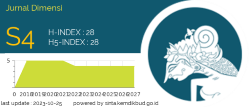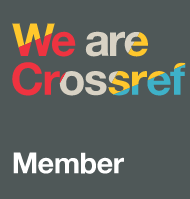FAKTOR EKSTERNAL PENDORONG KINERJA EKSPOR UNTUK INDUSTRI MANUFAKTUR
Abstract
Keywords
Full Text:
PDFReferences
ASEAN Secretary. (2019). https://asean.org/asean/asean-secretariat/secretary-general-of-asean/Bahrum, S. (2011). The urban developmental strategy and its regional implication: Batam’s case’, Proceedings of The 2nd International Syposium of Project Management Conference, Project Management Society, Batam, Indonesia, pp.39–48.
Barney, J.M. (1991). Firm resources and sustained competitive advantage, Journal of Management, Vol. 17 No. 1, pp. 99-120.
Beamish, P.W., Craig, R. and Mclellan, K. (1993) ‘The performance characteristics of Canadian versus U.K. Exporters in small and medium sized firms’, Management International Review, Vol. 33, No. 2, pp.121–137
Beamon, B. (1998). Chain design and analysis: models and methods”, International Journal of Production Economics, Vol. 55 No. 3, pp. 281-94.
Birru, W.T., Runhaar, P., Zaalberg, R., Lans , T & Mulder,M. (2019). Explaining Organizational Export Performance by Single and Combined International Business Competencies, Journal of Small Business Management, 57:3, 1172-1192, DOI: 10.1111/jsbm.12403
BPS, 2018. https://kepri.bps.go.id/pressrelease/2018/09/17/974/nilai-ekspor-provinsi-kepulauan-riau-bulan-agustus-2018-turun-19-77-persen.html
BPS. (2019) https://www.bps.go.id/pressrelease/2019/10/15/1574/ekspor-september-2019-mencapai-us--14-10-miliar--impor-september-2019-mencapai-us--14-26-miliar--naik-0-63-persen-dibanding-agustus-2019-.html
Cavusgil, T.S., Zou, S. (1994). Marketing strategy-performance relationship: an investigation of the empirical link in export market ventures, Journal of Marketing, Vol. 58 No. 1,pp. 420-37.
Chen, I.J., Paulraj, A. (2004). Understanding supply chain management: critical research and a theoretical framework, International Journal of Production Research, Vol. 42, pp. 131-63.
Doherty, S., Misrahi, T. (2013) ‘Outlook on the logistics and supply chain industry 2013’, World Economic Forum, Geneva, Switzerland.
Fawcett, S.E., Clinton, S.R. (1996). Enhancing logistics performance to improve the competitiveness of manufacturing organization. Production and Inventory Management, Vol. 37, pp. 40-6.
Fernando, Y., Fitrianingrum, A., Richardson. C. (2016). The effects of legal-political factors and market competition on supply chain performance: some findings from firms in a free trade zone.Int. J. Logistics Systems and Management, Vol. 24, No. 2, 2016.
Gao, G. Y., Murray, J. Y., Kotabe, M., & Lu, J. (2010). A strategy tripod perspective on export behaviors: Evidence from domestic and foreign firms based in an emerging economy. Journal of International Business Studies, 41(3), 377–396.
Gereffi, G., Sturgeon, T. (2013) ‘Global value chain-oriented industrial policy: the role of emerging economies’, in Elms, D.K. and Low, P. (Eds.): Global Value Chains in a Changing World, pp.329–360, World Trade Organization, Geneva.
Gorane, S.J., Kant, R. (2014) ‘Supply chain practices: study and framework for future development’, Int. J. Logistics Systems and Management, Vol. 17, No. 1, pp.83–103.
Green, K, W, Jr., Zelbst, P, J., Meacham &Bhadauria, V.S., (2012): Green supply chain management practices: impact on performanc, Supply Chain Management: An International Journal, Vol. 17 Iss: 3, pp.290 - 305
Gunasekaran, A., Patel, C., McGaughey, Ronald E., (2004). A framework for supply chain performance measurement. Int. J. Production Economics vol.87.pp 333–347
Hiatt, S. R., Sine, W. D. (2014). Clear and present danger: Planning and new venture survival amid political and civil violence. Strategic Management Journal, 35(5),
Hsu, C.C., Kannan, V.R., Tan, K.-C. and Leong, G.K. (2008). Information sharing, buyer-supplier relationships, and firm performance: a multi-region analysis. International Journal of Physical Distribution & Logistics Management, Vol. 38 No. 4.
Ibrahim, S,E., Ogunyemi ,O. (2012). The effect of linkages and information sharing on supply chain and export performance: An empirical study of Egyptian textile manufacturers. Journal of Manufacturing Technology Management, Vol. 23 Iss: 4 pp. 441 – 463
Krammer, S. M. S., Strange, R., Lashitew, A. (2018). The export performance of emerging economy firms: The influence of firm capabilities and institutional environments. International Business Review, 27(1), 218–230. doi:10.1016/j.ibusrev.2017.07.003
Kull, T.J., Ellis, S.C., Narasimhan, R. (2013). Reducing Behavioral Constraints To Supplier Integration: A Socio-Technical Systems Perspective. Journal of Supply Chain Management, January, 49,1
Law of Indonesian Republic No. 25 Year 2002 on the establishment of Kepulauan Riau Province
Lee, C.W., Kwon, I.W.G. Severance, D. (2007). Relationship between supply chain performance and degree of linkage among supplier, internal integration, and customer. Supply Chain Management: An International Journal, Vol. 12 No. 6, pp. 444-52.
Leonidou, L.C. (1995). Research on export barriers: review, assessment, and synthesis. Journal of International Marketing, Vol. 3 No. 1, pp. 29-43.
Li, Jing., Vertinsky, Ilan., Zhang, Hua. (2012). The Quality of Domestic Legal Institutions and Export Performance Theory and Evidence from China Management International Review. DOI 10.1007/s11575-012-0146
Morgan, R. E., Katsikeas, C.S. (1998). Exporting Problems of Industrial Manufacturers. Industrial Marketing Management 27, pp.161–17
O'Cass, A., Julian, CC. (2003).Examining firm and environmental influences on export marketing mix strategy and export performance of Australian exporters', European Journal of Marketing: Special Issue: Marketing Management in Australasia, vol.37,no. 3-4, pp. 366 384. ://dx.doi.org/10.1108/03090560310459005
Pujawan, I.N. (2004).Assessing supply chain flexibility: a conceptual framework and case study. Int. J. Integrated Supply Management, Vol. 1, No. 1, pp.79–97.
Rottig, D. (2016). Institutions and emerging economies: Effects and implications for multinational corporations. International Journal of Emerging Economies, 11(1), 2–17.
Ryoo, S.Y. and Kim, K.K. (2015).The impact of knowledge complementarities on supply chain performance through knowledge exchange. Expert Systems with Applications, Vol. 42, No. 6, pp.3029–3040.
Krammer, S.M.S., Strange R., Lashitew.,A. (2018) The export performance of emerging economy firms: The influence of firm capabilities and institutional environments. International Business Review.Volume 27, Issue 1, February 2018, Pages 218-230
Sukatia, I., Hamida, AB., Baharuna, R., Yusoffa, R & Anuara, MA. (2012). The Effect of Organizational Practices on Supply Chain Agility: An Empirical Investigation on Malaysia Manufacturing Industry. International Conference on Asia Pacific Business Innovation & Technology Management.
Snyder, Hannah. (2019). Literature review as a research methodology: An overview and guidelines. Journal of Business Research. Volume 104, November 2019, Pages 333-339
Tachizawa, E.C. Thomsen, C.G. (2007) ‘Drivers and sources of supply flexibility: an exploratory study’, International Journal of Operations and Production Management, Vol. 27, No. 10, pp.1115–1136.
Umeda, S (2013): Performance Management Framework for Reverse Supply Chain Systems by using. Modeling and Simulation Technologies. Proceedings of the 7th International Conference on Project Management, pp. 277-284
World Bank Group and World Trade Organization. The Role of Trade in Ending Poverty. World Trade Organization: Genewa, 2015 http://documents.worldbank.org/curated/en/726971467989468997/pdf/97607-REPLACEMENT-The-Role-of-Trade-in-Ending-Poverty.pdf
DOI: https://doi.org/10.33373/dms.v9i2.2540
Refbacks
- There are currently no refbacks.

This work is licensed under a Creative Commons Attribution-NonCommercial-ShareAlike 4.0 International License.











